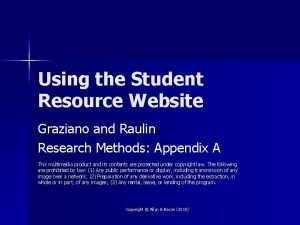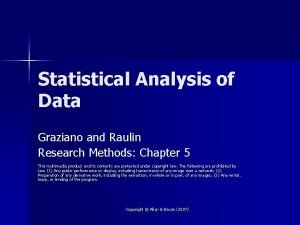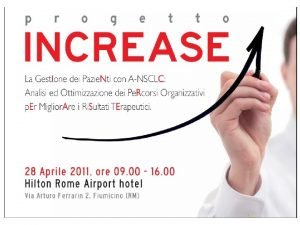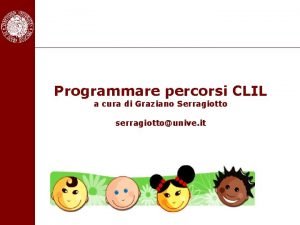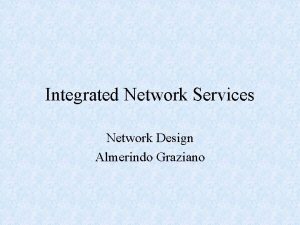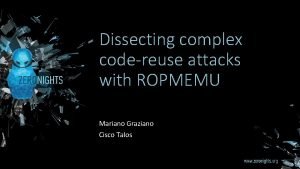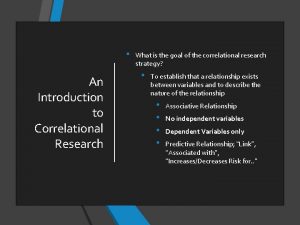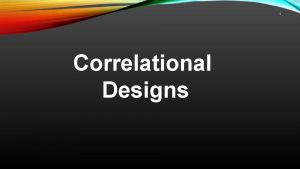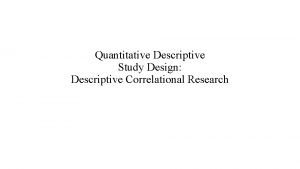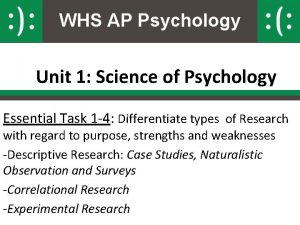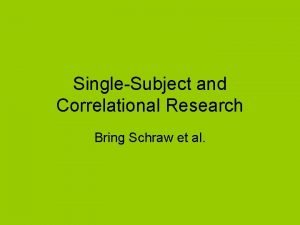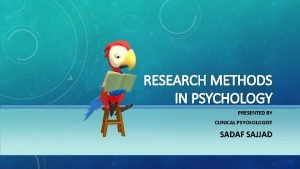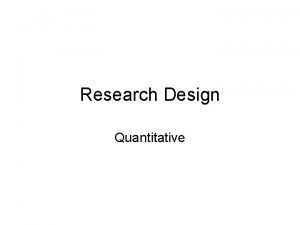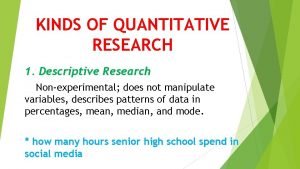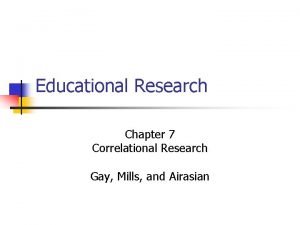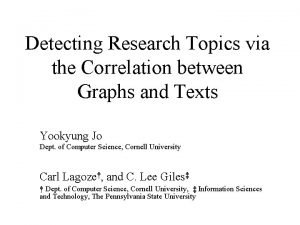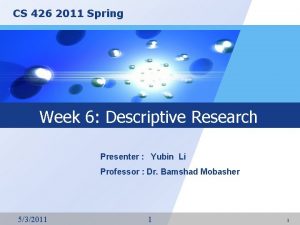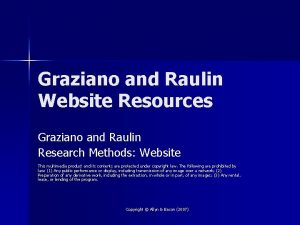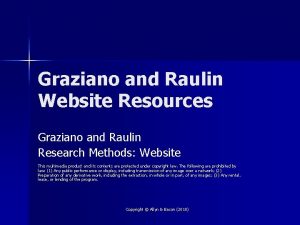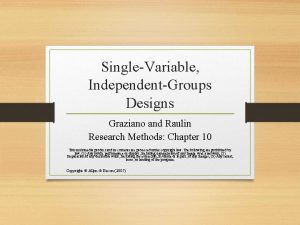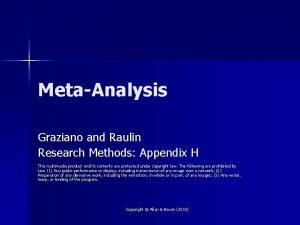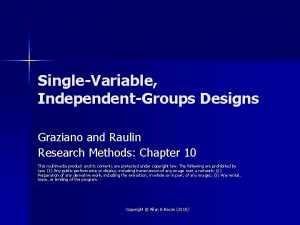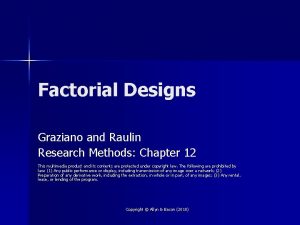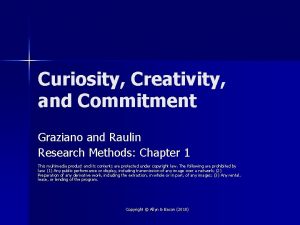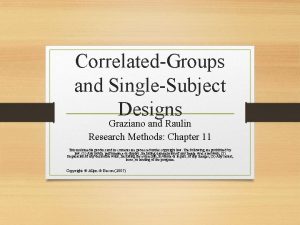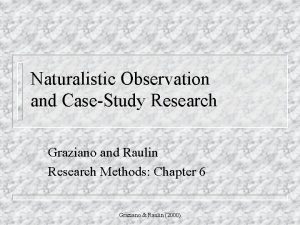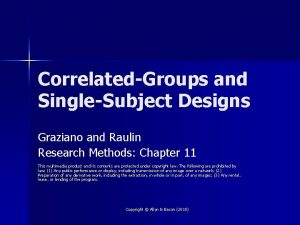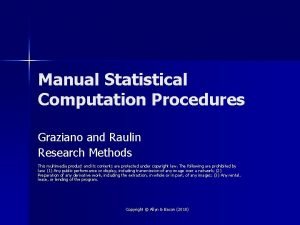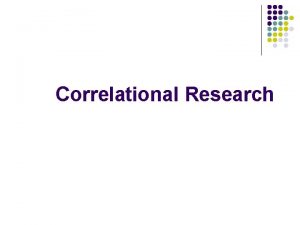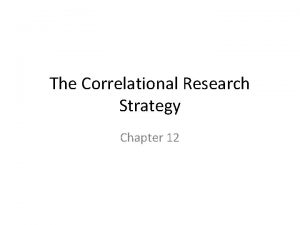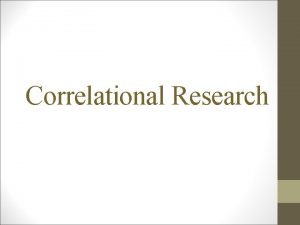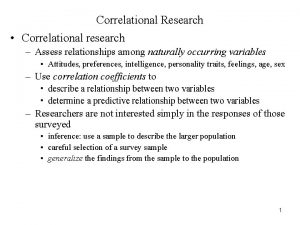Correlational and Differential Research Methods Graziano and Raulin






















- Slides: 22

Correlational and Differential Research Methods Graziano and Raulin Research Methods: Chapter 7 Graziano & Raulin (2000)

Correlational Research Methods Quantifies the strength of the relationship between two or more variables n Value of correlational research n – – Correlations can be used for prediction Evidence consistent or inconsistent with a theory n Cannot n prove a theory, but could negate a theory Correlations do not establish causation Graziano & Raulin (2000)

Differential Research Methods Compare two or more groups that are differentiated on a preexisting variable n Similar to both correlational and experimental research n – – n Same form as experimental research Conceptually same as correlational research (variables measured but not manipulated) Cross-sectional design is a special case of differential research Graziano & Raulin (2000)

Artifacts and Confounding Variables Comparing groups is reasonable only if we have standardized measurement procedures n Confounding occurs when two variables vary together n – – – Need to have them vary independently, usually by holding all but one variable constant Failing to provide this control could result in artifactual findings Procedures standardized for this reason Graziano & Raulin (2000)

Correlational versus Differential n Both involve the measurement, but not manipulation, of variables – n Therefore, neither is able to establish causation Differential is higher constraint because – – The researcher can select the comparison groups to control at least some of the potential confounding variables This provides stronger evidence for a theory Graziano & Raulin (2000)

When to Use Each Method n Correlational Method – – n When we are interested in knowing the strength of a relationship for predictive purposes Often included in larger research studies to provide data that might help us interpret the primary findings of the study Differential Research – When the manipulation of an independent variable is impractical, impossible, or unethical Graziano & Raulin (2000)

Doing Correlational Research n Steps in conducting correlational research – – – n Developing the problem statement Measuring the Variables Obtaining the Sample Analyzing the Data Interpreting the Results Correlational research is often embedded in larger studies Graziano & Raulin (2000)

Developing a Problem Statement “What is the relationship between variable X and variable Y? ” n Often want to correlate available demographic variables with the dependent measures or intercorrelate the dependent measures in higher-constraint research n – – Useful in detecting confounding variables Provides hypotheses for later research Graziano & Raulin (2000)

Measuring the Variables Need to use reliable and valid measures n Need to control n – Experimenter expectancy n Researchers – Experimenter reactivity n Researchers – tending to see what they expect to see unconsciously influencing participants Measurement reactivity n Participants responding differently because they know they are being observed Graziano & Raulin (2000)

Controlling these effects n Experimenter expectancy – n Experimenter reactivity – n Use objective measures whenever possible Minimize experimenter contact Measurement reactivity – – – Use filler items to distract participants Use unobtrusive measures when possible Separate the measurements in time Graziano & Raulin (2000)

Sampling Considerations Want the sample to be representative n Is the observed relationship the same in each subpopulation? n – – If we suspect such differences, we should compute the correlation in each subpopulation Moderator Variable: a variable that seems to modify the relationship between other variables n e. g. , sex: males and females showing different patterns of relationship between variables Graziano & Raulin (2000)

Analyzing the Data n Correlations range from -1. 00 to +1. 00 – – n Size indicates strength of the relationship Sign indicates direction of the relationship Many types of correlations – – – Pearson product-moment correlation Spearman rank-order correlation Advanced techniques (multiple correlation, canonical correlation, partial correlation, path analysis) Graziano & Raulin (2000)

Interpreting the Data n Note size and sign of correlation – n Is the correlation significantly different from zero (i. e. , evidence for a relationship)? – n Indicates strength and direction of relationship Is the p value < our selected alpha level? Coefficient of Determination – r 2 indicates the proportion of variance accounted for Graziano & Raulin (2000)

Doing Differential Research Developing the problem statement n Measuring the variables n Selecting appropriate control groups n Obtaining the sample n Analyzing the data n Interpreting the results n Graziano & Raulin (2000)

Developing a Problem Statement “Does Group A differ from Group B? ” n Strategies for developing good problem statements n – – – Select theoretically interesting groups to compare and compare them on theoretically interesting variables Best to compare groups that differ on only a single variable if possible Several comparisons are best Graziano & Raulin (2000)

Measuring the Variables Dependent variable is usually continuous, but could be categorical n Independent variable is categorical or is a continuous variable converted to categories n – n Unlike experimental research, the independent variable is measured rather than manipulated Need operational definitions for both the dependent and the independent variables Graziano & Raulin (2000)

Selecting Control Groups n Select control groups to avoid confounding – A variable can confound results only if a) it affects the scores on the dependent variable b) the groups differ on this variable n Ideal control group is identical to experimental group on all variables except the variable that defines the groups – Rarely possible, so multiple comparisons groups are typical Graziano & Raulin (2000)

Sampling of Participants Like all research, we want representative sampling to permit generalization n Many factors can bias the sampling process n – – – n Where we have access to participants How we go about identifying participants Even factors like time of day that we sample Participants who drop out of the study can limit generalizability Graziano & Raulin (2000)

Analyzing the Data Essentially the same procedures as those used to analyze experimental research n Type of analysis will depend on the number of groups and the level of measurement of the dependent variable(s) n – – – Score data: t-test or ANOVA Ordinal data: Mann-Whitney U-test Nominal data: Chi square Graziano & Raulin (2000)

Interpreting the Results Reject null hypothesis (of no group difference) if the p value is less than the alpha level that we set n Difficult to draw a strong conclusion from differential research because of n – – Sampling considerations Unlikely that all potential confounding variables will have been adequately controlled Graziano & Raulin (2000)

Limitations of these Methods n Problems in determining causation – A correlation does not imply causality n If A and B are correlated, then – – – n A could cause B B could cause A Some other variable could cause both Confounding variables – Without experimental control, it is virtually impossible to avoid confounding variables Graziano & Raulin (2000)

Summary Both correlational and differential research involves measuring the relationship between two or more variables n Drawing causal inferences without an actual manipulation is risky n Selecting appropriate control groups in the differential research design can control some, but typically not all, potential confounding variables n Graziano & Raulin (2000)
 Graziano and raulin
Graziano and raulin Graziano and raulin
Graziano and raulin Difference between comparative and correlational research
Difference between comparative and correlational research Othello shakespeare summary
Othello shakespeare summary Filippo de marinis oncologo
Filippo de marinis oncologo Graziano serragiotto
Graziano serragiotto Almerindo graziano
Almerindo graziano Mariano graziano
Mariano graziano Roderigo archetype
Roderigo archetype Concordia discordantium canonum
Concordia discordantium canonum Strengths and weaknesses of correlational research
Strengths and weaknesses of correlational research Strength and weaknesses of correlational research
Strength and weaknesses of correlational research Preference for specific design control for procedural bias
Preference for specific design control for procedural bias Descriptive correlational design
Descriptive correlational design Correlational research psychology
Correlational research psychology Correlational research
Correlational research Experimental method in psychology
Experimental method in psychology Symbolic representation in research
Symbolic representation in research Cross-sectional correlational design
Cross-sectional correlational design Descriptive research design
Descriptive research design Correlational study
Correlational study Correlational research topics
Correlational research topics Descriptive vs correlational vs experimental research
Descriptive vs correlational vs experimental research
